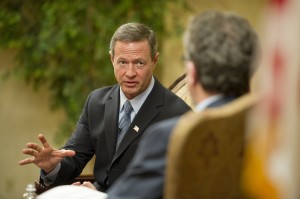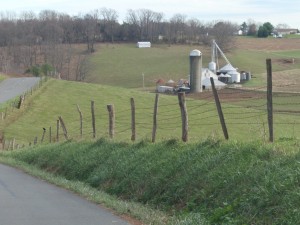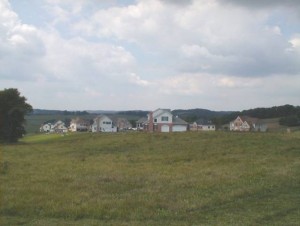States address farmland preservation funds
HARRISBURG, PA – Gov. Tom Corbett’s proposed budget, introduced Feb. 7, includes a plan to divert revenues dedicated to farmland preservation to the state’s troubled general fund. The state farmland preservation program’s primary source of funding is a portion of the state tax on packs of cigarettes that each year has put $20.5 million into the purchase of agricultural conservation easements.
The governor proposes to substitute the dedicated fund with “excess” Growing Greener 2 funding, which comes from bond funds and municipal waste disposal fees. While passage of legislation to continue the fund coincided with release of the budget, it is just a first step to securing money for environmental projects in the state. While the Renew Growing Greener Coalition of environmental groups is relieved that mechanisms for funding are in place, the vote is nothing to celebrate: Growing Greener projects and grants fell from an average of about $150 million per year for the last six years to $27.3 million in the current state budget, a more than 80 percent reduction.
Doug Wolfgang, director of the Pa. Bureau of Farmland Preservation, informed county level administrators that in the FY 12/13 budget “the program’s portion of cigarette tax funds ($20.5 million) will be retained in the general fund. Excess Growing Greener 2 funds will replace funds the program would otherwise receive through cigarette taxes for the next two years – essentially holding the program harmless for that time period. The farmland preservation program spent its share of Growing Greener 2 funds – $80 million. The proposal is for additional excess Growing Greener 2 funds to be used for the program.”
According to Ellen Dayhoff and Matt Knepper, president and vice president of the Pa. Farmland Preservation Association, the proposed budget would “permanently eliminate cigarette tax revenue funding for farmland preservation, and instead direct that revenue to the General Fund. Other funding comes from the Environmental Stewardship Fund (ESF), which is inadequate for a statewide easement purchase program, amounting to less than $6 million annually over the last three years.
There is some irony in the move to plunder the farmland preservation fund because this source of dedicated revenue to the program started out as a percentage of a two-cent tax on packs of cigarettes. But, in 2002, amidst concerns that increased awareness of tobacco-related illness might result in decreased funding over time, the dedication was changed from a percentage to a flat appropriation “to provide greater fund stability.”
Until now, the cigarette tax revenue has been dependable. But Pennsylvania lawmakers may be following Maryland’s lead and pulling on farmland preservation funds while the troubled real estate market douses the urgency of protecting land from development. Maryland lawmakers have been raiding dedicated farmland and open space preservation revenue sources since 2008. But in some cases, those diverted funds were “backfilled” with bond money, and Pennsylvania lawmakers may be looking to do the same.
For the years 2012 and 2013, according to Dayhoff and Knepper, the governor’s budget proposes to replace the cigarette tax revenue “with an equal amount of anticipated excess Growing Greener funds from bond premiums. After 2013, the only funds remaining for farmland preservation at the state level would be those from the Environmental Stewardship Fund. If the Governor’s budget passes as currently written, it’s entirely possible that there will be no meaningful amount of state funding available for farmland preservation after 2013,” Dayhoff and Knepper wrote in a message to PFPA members, urging them to contact their legislators.
Growing Greener started in 1999 when the legislature and governor allocated $650 million to environmental projects. In 2002 the Environmental Stewardship Fund (ESF) was created as a boost to Growing Greener programs. The ESF was supported by a landfill tipping fee and 14.8 percent of its proceeds was dedicated to farmland preservation. In 2005 Gov. Ed Rendell and lawmakers placed a $625 million bond referendum for the environment on the ballot, which voters passed by 60%. From that, $80 million was allocated for farmland preservation. Those funds are spent. In 2012, the ESF is projected to generate only about $2.5 million, down from $5.3 million in 2011 and $4.6 million in 2010. The reason for the diminishing funds is that in 2005, after the bond referendum was passed, the governor and legislature passed a provision in the implementing law that allowed for using revenues from the ESF to pay down the debt of the bonds.
In 2010, $57.8 million in combined municipal, county, state and federal funding was spent in Pennsylvania for farmland preservation, and since the program’s inception in 1988 more than $1 billion of combined funds has been spent for conservation easements.
The Pennsylvania program has preserved 457,537 acres and 4,229 farms.
In Virginia, Gov. Bob McDonnell announced in January that $1.2 million was allocated for farmland preservation grants to 13 localities. McDonnell said he has also proposed the same amount in matching funds to local programs for the next two fiscal years. “I’m hopeful the General Assembly will accept this proposal so we can continue to work with localities to preserve our valuable working farmlands.”
But the amount of money McDonnell has set aside is once again scanty compared to what is spent annually in neighboring states and won’t go far. Based on easement transactions completed in Virginia in 2011, the $1.2 million will only pay for 837 acres. In 2011, the state contributed just $382,812 toward the preservation of 1,024 acres, or a matching amount of $373.83 per acre. Localities put up $1,083,563 for a total of $1,466,375 spent in the state in 2011, with an average per-acre total cost of $1,432.
Even so, McDonnell said he and the General Assembly “are committed to setting aside funds for preserving working farmland,” and that one of his top priorities is to permanently preserve 400,000 acres during his administration.
The governor’s press release didn’t mention that most of the preserved land that would make up the acreage goal would have to come through donation of easements that may or may not protect the state’s agricultural lands. The Virginia Conservation Tax Credit allows donors of easements or lands to claim an income tax credit of 40 percent of the appraised value of the donation. In the credit’s early years, donors were allowed to claim up to $100,000 the first year and 10 subsequent tax years, but the law was amended for the 2009 tax year to allow a $50,000 credit to be claimed and for 12 subsequent years. The credit has been an attractive incentive even for those without an income tax burden, because the credit can be sold. Several brokerage firms in the state specialize in such transactions.
The Conservation Tax Credit is responsible for most of the state’s treasury of 800,000 preserved acres, mostly held by the Virginia Outdoors Foundation. Meanwhile, the state agricultural land preservation program continues as an adjunct to the conservation tax credit, with successive governors claiming large increases in funding when the allocation reaches $1 million, which is a large increase over the program’s low point allocation of $100,000.
In Maryland, Gov. Martin O’Malley has proposed $14.8 million for the Rural Legacy Program, and $24 million for the Maryland Agricultural Land Preservation Program. While these amounts are not expected to stand, it is a busy session in Annapolis with legislation that is designed to protect agricultural land and cut the amount of pollution flowing into the Chesapeake Bay.
While SB 236, the Sustainable Growth and Agricultural Preservation Act of 2012 is described by opponents as an affront to its own title, a campaign by some state leaders to control sprawl development where localities have refused to do so appears to be moving along so far without the level of opposition that would be expected. The bill would place approval for much rural development in the hands of state planners, not through a typical zoning mechanism but through defining growth in terms of number of new septic systems polluting the bay. Federal mandates for cleaning up the Bay have put legislators in a position to cite such measures as necessary, and those legislators in leadership positions believe they have the votes to pass the measure.
The bill’s Fiscal Note, which is 21 pages long and offers a comprehensive discussion of the bill, states that while localities may experience greater expenditures in the costs of planning or health department regulatory additions, local expenditures also “may decrease due to savings associated with implementing state and federal environmental mandates” and due to fewer services to render in the future. The note also states that “special fund revenues” to certain state agencies “may decrease to the extent that development and sale of new residential property decreases under the bill’s restrictions.” Two state agencies, the Dept. of Agriculture and the Dept. of Natural Resources, receive funding for land preservation under the state’s real estate transfer tax and agricultural land transfer tax, revenues that have traditionally paid for land preservation in the state.
Gov. O’Malley has put bay cleanup among his top priorities. He has consistently identified farmland preservation as part of the solution to improving the bay. This year he has put more emphasis on curbing rural development and construction of septic fields. In his State of the State address, he thanked the legislature for “the tremendous amount of time and consideration that many you have given over the interim to curbing the growing problem of septic pollution from large-scale housing developments; large-scale housing developments that threaten the Bay and the future of Maryland agriculture. A house on septic causes six to ten times the amount of pollution to the Bay as a house on public sewer. In fact, of the four largest causes of nitrogen pollution into the Bay, none is growing faster than septic pollution. … this measure will much better protect the agricultural lands upon which family farming depends; it will better protect the waters of the Bay; and it will save all of us a huge amount of money in remediation costs down the road.”
How the ‘septic bill’ would affect the state’s multiple programs that purchase conservation easements on farmland is not addressed in the bill.
Also in Maryland, legislation that would exempt from the Maryland estate tax up to $5 million of the value of agricultural property is moving with more positive action than in previous years and is widely expected to pass.
“The estate tax is a significant burden on farm families, especially in urban and suburban areas where land values are high and farmland is most at risk,” stated Kelly Carneal, Rural Lands director for 1000 Friends of Maryland in testimony on SB295. “It has become critical that we look for other funding sources to enhance preservation efforts. This bill creates incentives for agricultural preservation and eliminates the risk to farmers of preserving their land.
Carneal said this year the bill has more support than last year, when a pilot tax break was passed that allowed farm families to defer payment of the Maryland estate tax pending settlement of a conservation easement. A permanent estate tax break is needed even more, she said, since fewer farm families will be receiving offers for easements as land preservation program budgets expect to be cut once again this year.
Maryland governor orders state plan implemented
ANNAPOLIS, MD – Gov. Martin O’Malley signed an executive order in December directing state agencies to begin implementing a state plan finalized this fall and dubbed PlanMaryland. The plan puts into place smart growth guidelines for state agencies to follow before approving state construction projects and to apply when working with local governments on projects involving state assistance.
According to the Maryland Department of Planning website, PlanMaryland “proposes to build on existing State and local plans and programs toward a new level of accountability from State agencies and local governments. The focus is not on new programs, more money or more State control. Instead, a new emphasis would be placed on the ways in which individual State agencies and local governments coordinate and work together on their respective responsibilities and actions.”
Gov. O’Malley at the start of this year’s legislative session that began Jan. 11, called the state plan overdue and said Maryland would no longer “finance sprawl.”
PlanMaryland has met with resistance, some of it vehement, from mostly rural counties whose elected officials claim the newly adopted policies will usurp their local planning and zoning powers. Two bills were introduced in the House of Delegates on the first day of the legislative session that would stop PlanMaryland from being implemented unless it is approved by the General Assembly. Some local elected officials have accused the governor of overreaching and believe that PlanMaryland is a power-grab by the state. The governor did not need legislative action to put the plan into effect.
The governor stated that PlanMaryland will not dictate local land use decisions, but it will funnel state spending to projects that meet the state’s definition of smart growth, and steer money away from those projects that are unnecessarily located away from existing infrastructure.
The governor called upon the Department of Planning several years ago to develop the plan that was authorized by the legislature in the 1970s but never put into motion despite a number of governors who supported growth management. The move expands the smart growth actions taken by former Gov. Parris Glendening, who joined O’Malley in announcing PlanMaryland. Former Gov. Harry Hughes also joined in the announcement. O’Malley and both former governors are Democrats.
For decades, cleaning up the Chesapeake Bay has motivated state leaders to seek restrictions on land use. Now, under EPA rules, Mid-Atlantic states are required to stem pollution going into the Bay by 25 percent by the year 2025. Funding the cleanup began in 2004 with The Bay Restoration Fund, referred to as “the flush tax”. It charges owners of private, residential wells and septic systems $30 annually and the revenues are used to upgrade sewage systems. The 2012 Maryland Legislature will consider legislation to double or even triple the fee. Local officials are still fuming over legislation that was introduced but then withdrawn last year that would have restricted use of septic systems by prohibiting large subdivisions in rural areas across the state. They have a second round this year with the bill’s reintroduction as the Sustainable Growth & Farmland Preservation Act of 2012 or SB 236. The bill put forward by the O’Malley administration is sponsored by legislators from Montgomery and Prince George’s Counties.
Maryland seems to be bucking a trend nationwide when it comes to state involvement in land use. Oregon led the nation from the early 1970s to the early 2000s with statewide planning that included a requirement for county exclusive farm use zones. These zones were rendered less restrictive by Ballot Measure 49 of 2007, but the measure headed off attempts to return many agricultural properties to their pre-1973 zoning and open up rural areas to widespread residential development.
Maine had statewide planning functions until late last year when a new administration began dismantling the Maine Office of Planning, moving some of its functions to other agencies and repealing others. State planning units in Washington and Hawaii have been restructured to a less regulatory stance in recent years.
Efforts by the Glendening administration a decade ago to channel state assistance into priority funding or smart growth areas was deemed to be largely ineffective. But PlanMaryland may now be the nation’s most extensive state-level initiative to curb sprawl and protect natural resources. While PlanMaryland does not create a zoning standard, its implementation may enable the state to delay or withhold funding to counties if development projects encroach upon agricultural or natural resource areas.
Local elected officials have resisted adoption of PlanMaryland since last fall when a deadline for comments was extended because local officials complained they had not had enough time to review the plan. Commissioners in Carroll County claim PlanMaryland is an outgrowth of environmental protectionism whose principals are based on the flawed science that identifies human activity as causing climate change. They also claim the new state plan violates citizens’ 5th and 14th amendment rights.
PlanMaryland, said Carroll Commissioner Richard Rothschild, is “a bridge too far. We’ve embraced smart growth, but this plan shifts authority away from local officials and is based on flawed science.”
Rothschild said the plan will allow the state to withhold permits as well as financial support to capital projects. A number of local officials from rural localities rallied in Annapolis in October to oppose adoption of PlanMaryland.
Richard Hall, secretary of the Maryland Department of Planning, said PlanMaryland “does not create new law – it’s a playbook strategy that ties together smart growth programs that have been around for decades.” Hall said the plan is timely, in that tough fiscal circumstances require more careful spending and planning for public needs. “For decades now, we have been over-consuming our land, destroying farms and forests, harming our environment and over-crowding our under-invested transit ways leading to some of the worst commute times in our country. For decades, we have been moving in a direction that’s not sustainable, not cost-effective and imperils the very reasons we love Maryland.” Sustainability has become the watchword in the state’s lexicon.
According to the Dept. of Planning, between 1982 and 2007, total farmland in the state declined by one-fifth, or 500,000 acres.
It is unclear whether the state subcabinet that has been charged with implementing PlanMaryland will consider agricultural zoning as a measure of a county’s smart growth practice. Agricultural protection zoning is widely seen as the most desired foundation for farmland preservation, which state leaders see as a vital component of smart growth.
If agricultural protection zoning were scrutinized by the state, only a few counties would measure up without difficulty. Baltimore County’s growth policies that date back to the 1960s served as a model for some of the thinking behind PlanMaryland. Baltimore and Montgomery County lead the state in smart growth and in protection of farmland and open space. Baltimore County has the state’s strictest agricultural protection zoning, allowing approximately one dwelling per 50 acres. Montgomery County’s transfer of development rights program in 1980 put in place a residual density, that is, if TDRs are not used, of one dwelling per 25 acres in the county’s designated agricultural preserve region.
But other counties may have some explaining to do under PlanMaryland. For example, Harford County’s elected leaders have long pledged not to revisit agricultural zoning that has allowed dozens of major subdivisions throughout its rural areas where many millions of local dollars have been spent on purchasing development rights since 1993. While Carroll County ranks 4th in the nation for number of acres preserved in a farmland preservation program, its agricultural zoning may be on a par with Harford’s. On the books, Harford’s ag zoning allows one dwelling per 10 acres (1:10), and Carroll’s agricultural zoning restricts density to 1:20. But multiple-parcel allowances and add-ons referred to as conveyances and hangover parcels (parcels severed from the parent parcels by a public road) enable landowners to easily get beyond the stated density. All these allowances make for an on-the-ground agricultural zoning that is far less restrictive than stated. It is hard to predict how actual subdivision practice will be scrutinized under PlanMaryland.
Other Maryland counties have supported farmland preservation for decades, but just as fervently supported keeping zoning so permissive it compromised the investment of tens of millions spent on purchase of development rights. Howard County, which was once a leader in farmland preservation, never enacted agricultural protection zoning, and housing density permitted in the agricultural area where the county paid to retire development rights on more than 20,000 acres, remains at one dwelling per 4.25 acres if clustering is used. Non-cluster subdivision carries a minimum lot size of three acres. Parcels over 20 acres must use the cluster provision.
While Maryland is seen as a leader nationally in land protection, many counties throughout the state lack zoning that restricts residential development to protect agriculture, yet those counties administer farmland preservation programs using millions of state dollars. Under PlanMaryland those counties may now be advised to scrutinize development projects and tighten regulations and policies or face scrutiny themselves when they seek assistance from state coffers.
PROGRAM BRIEFS
In Maryland … The owner of a 950-acre property in Talbot County on the Eastern Shore has donated the development rights to the state Department of Natural Resources. The property includes both agricultural and natural lands and is the first easement donation in the history of Program Open Space to include public access. Hunting, horseback riding, hiking, kayaking and fishing will be allowed on sections of the property. Grasslands and croplands on the property provide foraging areas for nearly 200 migratory birds. …..In Frederick County, a citizen group along with two regional environmental organizations filed a lawsuit in Dec. against county commissioners who reopened zoning decisions made by a previous board in order to allow affected landowners to reclaim building rights they lost in a downzoning that occurred in 2010. There were 193 requests for reverting zoning, with the potential for more than 17,000 new homes, according to county planners. In Carroll County… County commissioners created a task force to examine the county’s farmland preservation program’s use of installment purchases as well as the potential for term easements and transfer of development rights. After four meetings, the group told commissioners in Dec. that term easements were a nonstarter, TDR had very limited potential, and the county’s innovative installment purchase program, despite requiring a yearly payment of interest from general funds, was a good deal for the county and should be continued “until it can be clearly demonstrated” that the annual payout of interest, now at $933,000, is beyond the county’s ability. The program, on hold since the commissioners called for creation of the task force at the end of May last year, will begin a new sign-up period in February, according to program manager Ralph Robertson.
In Pennsylvania … County farmland preservation programs are within their rights if they want to charge fees for reviewing subdivision plans on preserved farms or processing applications, according to an opinion issued by the Governor’s Office of General Counsel. Some counties had been charging fees but whether they had the authority to do so has been an issue for more than a year. The unresolved issue caused the state board to put county program recertifications on hold over the last year. Some counties, including Lancaster and Adams, charge fees for processing applications or reviewing plans for subdivision. Members of the Pa. Farmland Preservation Association last year ranked the ability to charge reasonable fees for administrative services 15th in a list of 31 items of concern for county programs.
BOOK REVIEW
Strategic Conservation Planning has plenty of good advice
Ole M. Amundsen, III. Strategic Conservation Planning. Washington, DC: Land Trust Alliance. 2001, 312pp. (paper). $24.95 or $10 as a pdf download. Available at http://www.landtrustalliance.org/training/publications/publications-1
Farmland preservation, whether managed by a public agency or a private land trust, has often been criticized for being opportunitistic rather than strategic. Ideally, farmland will be preserved in large contiguous blocks of 1,000 or more acres. This pattern not only protects farm operators from intrusive non-farm neighbors, but also helps direct development to appropriate locations with adequate public services. Yet, farmland preservation depends on landowners who are willing to sell or donate conservation easements. Some or many landowners may choose not to preserve their farms, making it hard to assemble large contiguous blocks of preserved land.
Opportunistic means that a land trust or government agency literally works with any landowner that makes contact: the owner of a 40 acre farm with development on three sides or 400 acres in the heart of a farming area. The risk with the opportunistic approach is that mainly small, unconnected parcels will be preserved. If the zoning on adjacent land allows a fairly high density, such as one house (or more) per two acres, then the preserved land may act as a magnet for new development thanks to the “permanent view” it provides. The newcomers are likely to complain about the farming operation next door, especially if there are livestock, and make life difficult for the farmer.
So how can land trusts and government agencies be strategic in their land preservation efforts?
In Strategic Conservation Planning, Ole Amundsen offers several answers along with abundant good advice. The book is well-organized and clearly written in a step-by-step approach to integrating strategic thinking into land preservation programs. Amundsen, who works for the Conservation Fund, provides a wealth of examples that are useful to both large and small land preservation organizations.
Strategic Conservation Planning was published by the Land Trust Alliance as part of their Standards and Practices Curriculum for land trust accreditation. The accreditation process emerged in response to the need for greater professionalism and consistency in land preservation. To date, more than 130 land trusts out of more than 1,700 have been officially accredited by LTA.
Strategic Conservation Planning has a long range focus, which is reflected in the five chapters: 1. The Importance of Strategic Conservation Planning; 2. Preparing for the Strategic Conservation Planning Process; 3. Understanding Your Community; 4. Setting Land Conservation Priorities; and 5. Implementation.
The pay-off is that strategic farmland preservation will make the land preservation organization more effective and will result in more land under easement. Finding partners in preservation, GIS mapping, ranking systems, and prioritizing land preservation projects are all key, especially when financial resources are tight. The traditional, but crude, measure of success is “bucks and acres;” we spent x dollars and preserved y acres. But this measure has much less meaning on the ground where the quality of the natural and cultural resources being protected and the pattern of land preservation are paramount.
One of the main obstacles that land preservation organizations face is the lack of self-assessment: How are we doing in carrying out our mission and what could we be doing better? Amundsen combines examples and advice on how to incorporate strategic thinking into the self-assessemnt process.
Even though Strategic Conservation Planning is aimed at land trusts, administrators of government farmland preservation programs will also greatly benefit from reading the book and sharing it with their boards. The emphasis on planning over the long term is refreshing. This approach does not detract from the urgency that drives land preservation. Rather, Amundsen estimates that it will take a year to a year and a half to fully implement strategic planning for land preservation.
My good friend, Jack Wright, Professor of Geography at New Mexico State University and a seasoned land preservation practitioner, once wrote that land trusts are de facto (in effect) land use planning agencies. The same is true of government land preservation departments. For too long, planning in the United States has meant planning for development. Now, land trusts, government agencies, and communities all across America are recognizing the need to plan for land preservation as well. Strategic Conservation Planning presents a workable process and a useful set of tools to do that.
JOB POSTING
Cherry Grove Farm, maker of artisanal cheeses, seeks general manager
 Cherry Grove Farm, located in the historic district of Lawrenceville, NJ, is seeking a general manager. The farm produces and markets fine artisanal cheeses, grass-fed meats, and other farm products. The owners are committed to the principles of sustainability, environmental conservation, community engagement and excellence in our products.
Cherry Grove Farm, located in the historic district of Lawrenceville, NJ, is seeking a general manager. The farm produces and markets fine artisanal cheeses, grass-fed meats, and other farm products. The owners are committed to the principles of sustainability, environmental conservation, community engagement and excellence in our products.
The farm is uniquely situated on a heavily travelled state highway in the heart of the Philadelphia – New York Corridor, where many retail stores, restaurants and families value high-quality products from local sources. Established points of sale include an on-farm store, seasonal farm markets, year-round wholesale to restaurants and retail markets, and a growing web-based presence.
The Manager (or, couple) will be in charge of all aspects of farm management from production to marketing. He or she will be a person with demonstrated supervisory and management experience; a friendly, outgoing and inclusive manner; and creative passion for the production and marketing of local agricultural products. Appropriate backgrounds may include sustainable agricultural production, experience in food sales or distribution, or some combination of these qualifications.
Oliver, Bill and Sam Hamill, Owners ~ Please send inquiries and qualifications to Sam Hamill, smhjr@ix.netcom.com




